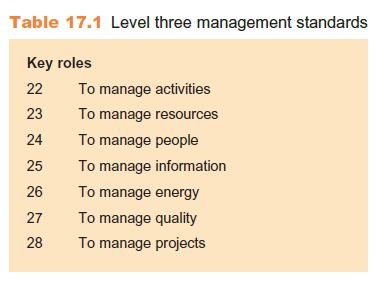NVQs – Its Advantages and Characteristics
Revolutions in multiple numbers came up as a vehicle for National Vocational Qualifications. Because of such attempts,an unstructured and wide range of vocational qualifications were brought together. This brought to light 2extremely different aspects. Either the qualifications were routed to NVQ competence, or the pathway for it was direct. Suppose, if it was seen that nature of any qualification was different, it was made sure that recognition was madeto something nearly equal to that of a particular NVQ level.
We are already aware that there are quite a lot of occupational areas. When analyzation and rankings are made for any occupation, it is assured that it passes from the 5 NVQ level. Where 5th level is dedicated to all the complicated tasks, the 1st level is related to the common routine work. For the rest levels, i.e., level 3rd, 4th, and 5th, all are for management occupation. However, it is to be noted that being at different levels, the standards do possess variations.
There may be many factors when it comes to training for competence. However, it is a basic thing that most people forget. Competence training should be related to the criterion which is set for it. It is mostly focused on ability development for a particular task that is required to be fulfilled by a trainee.
There are aspects with the help of which ability development can be achieved.
- Preparation relate to a particular job
- Precise expression which makes sure that positive outcome can be achieved via performance
- Particular indicators to attain it
This can be called a realistic approach that breaks the figurative approach of completing training to that of scattering confetti.
Where the process seems to be easy to understand, the standards set to achieve it are no doubt complicated.One of the important things that you need to an understanding about these set standards is its typical work –taking a particular job and dividing it on the basis of different roles.
Instance to explain the concept
During 1997, management standards saw few tweaks in level 3. Few updates were made on that level. Due to this up gradation, light was thrown on a job and from that 7 job roles were recognized. It is clearly highlighted in the table highlighted below.
 Now again it was seen that there was possible development on 4amongst those 7. The standards on this were potential on the generalized side. Again it was decided that those 4 job roles were dividedin to competence units. As a further step, it was decided that more subdivisions were included making it into smaller elements. These elements were ensured to attach on range statements and performance criteria.
Now again it was seen that there was possible development on 4amongst those 7. The standards on this were potential on the generalized side. Again it was decided that those 4 job roles were dividedin to competence units. As a further step, it was decided that more subdivisions were included making it into smaller elements. These elements were ensured to attach on range statements and performance criteria.
Shifting our focus on the other country, preferably UK, developments are considered both in education and changes implied on it as well as in competence standards. In the former sector, the elements are mostly:
- GCSE
- National Curriculum
- Problem-based learning
- Experiential learning
These are just the preliminary aspects. It actually is an attempt to enhance a learner’s capability to be more on the active side of a task rather than focusing only on the side of having knowledge. Giving a better flexibility to a learner, it enhances the learning process. Making it a plus point, a learner will not be restricted to open for institutions related just to education.
Designing of these standards are made in such a way that most people going through the training process will be able to complete their task during the ‘on job’ phase. There may be few inputs that information providers can give, but the major portion of work has to be done by the aspirant.
After the complete task is over, the step is an assessment of the work that has been completed by the aspirant. It is only on the basis of that work that certification or grades can be awarded to that aspirant.
We have already made some discussions related to competencies and its principles. It is due to these principles which ensure a path related to national vocational qualifications. Some of those principles are as follows:
- There are cases where you can see that most people are more interested in the learning process rather than thinking about the fact what they can do with that knowledge. An example to explain this fact is a student thinking to take up master’s degree program. Even if the least considerable time is taken, that student has to complete at least a year of that program. The focus of that student should be to clear his or her competence-based qualifications. If that person fares well, they will automatically get their degree. In this case, the period of its completion comes second to that of demonstrating outstanding performance.
- It should be strictly maintained that there should be use of fair means when it comes to training. Any barrier to this process is strictly prohibited. An instance of such barriers can be in the form of legalized bodies,
- The Law Society
- Chartered Institute of Personnel and Development
What should be maintained in this NVQ procedure are no particular prior qualifications to attain it.
- When researching about assessment basics, features related to performance standards comes to be one of the key elements. Basically, it has to be directly used in the practical approach rather than sticking with case studies (written-up) or in essay format. There are so many schemes that are associated with training methodology, but when it comes on the grounds of competence, it can be said that it only has a single standard.
If you want to see the differentiation degree, it basically lies on the shoulders of the trainees. In order to get qualified, the main area lies on the period that is utilized by different trainees as per their ability.
- There is no hard and fast rule regarding the training procedure if it follows National vocational qualifications. Being in control of a singular body, every vocational area is set to be same for every candidate and every training institute.It usually follows one rule – rival qualifications cannot be multiplied with this particular qualification. The main body or council that governs all the rules and regulations in this context is NCVQ or National Council for Vocational Qualifications.
- Another of the important factors is certification related to learning and working experience that a person has earned beforehand. This can be easily attained despite of any specific procedure.There can’t be any value of a skill if you learn it and do not get the certification for it. In case you have multiple skills that you have developed beforehand, you can demonstrate your competence and receive accreditation.
- There requires being flexibility when it comes to the learning procedure. It is imperative that transference of knowledge is smooth between providers. Again, being tied to a single educative institution is something that should not be made mandatory. There should be more stress on imparting of knowledge than focusing on the attendance of the candidates to gain those details.
The candidates should be given enough freedom so that they can start taking the required knowledge and hone their skills rather than fixating on certain elements and trying to complete those. This explains the factor that work can be executed as the demands and standards of a business.
- There are specific colleges and schools that have already replaced institutes regarding BTec and that of qualifications that are similar to it. One of such institute based on this concept is GNVQs or General National Vocational Qualifications.
- Evaluations of test can be tiresome but of great importance. If you want to analyze the result of competence, then written examination cannot be considered to be an appropriate option for it. Another of the important aspects to evaluate competence is the presence of an assessor who is aptly qualified to record the result. The analyzation should be as per the scheme related to 2 units and held under Training and Development Lead Body.
To some extent,the evaluation should be via portfolio. But it also should be maintained that the majority should be related to the task that is given to the candidate. In the initial phase, it was only in a workplace where this task completion was mandatory. Later it was seen that this procedure was becoming a bit difficult to be executed in every case.
- If there are companies who wish to acquire certification of any specific type, then they have to follow some of the set standards established by designated lead bodies. These bodies generally comprise of professional bodies, huge committees dedicated to practitioners and many others of similar judiciary power. It can be stated that decisions related to vocational standards are decided not by a classroom in charge but by the one who handles the workplace charges.
- It is not necessary that if you have the qualification of a certain skill at present, it will be liable to fetch you a job in the near future It can only be possible if you either extend your competence or update it. If not, there could be serious consequences like loss of qualification.
- There are certain principles following which an applicant can induce some form of flexibility in the evaluation process. One of such cases is the regular monitoring of the evidence related to accumulation of competence. It can be on daily record so that you can submit the precise details in an appropriate way. As you can see the table highlighted above, there are other chapters dedicated solely to the technological use to improvise portfolio compilation.
- Until and unless there is a learning contract when considering about any training approach, the process cannot be preceded. This establishment has to be between trainee and provider. Responsibility for information transfer is on the shoulders of both parties. It is the responsibility of the trainee to ask and ensure of the facilities and the help that he can avail from the trainer. Again, the response from the side of the provider is to ensure that the trainee gets all the essentialities valid for the training. This is extremely important as this concept teaches the learner to be true to his or her commitment and be active to accept all the positive and challenging factors during the learning process.
If you are piqued about the intentions of such approach, the main idea is to make traditional academic qualifications work on the same side and run parallel with NVQs. This effort is considered to be at the undergraduate level.
Now, when we are talking about the set standards by NVQs, there are few quarters where the support has been observing to be stronger than the other. However, there are also some not so positive reports when it comes to the analysis of the advantages related to the advantages of these set standards.
There has been a certain report that has been presented in the year 1999 by Winterton and Winterton. As per that, there has been a noticeable improvement in certain companies who adopted the set management standards. As per those firms, they saw the benefit in the form of:
- Easy recognition of competence development targets
- Recognize the gaps present in competence
- Career progression
- Recognizing the criteria in an uncomplicated and simple way when planning for human resource
- Development of logical structure for skill development and training process
In order to understand the concept, we need to relate the entire concept with management standards. It has always been observed that those candidates who had already had the skills of ruling out the managerial role in them have pre-developed self-confidence level. When they are given proper training, they are highly motivated to get themselves honed and develop better organizing skills. Holman and Hall also stated that these candidates are more susceptible to improve their concentration on any given task.
This has been seen that this entire process is considered as a type of rite of skill honing who are newly introduced to the world of management and managerial post.
NVQs and few important problematic aspects related to it
Where there have been advantages in the set standards of NVQs, there is also another side of describing about the difficult aspects of it. It was after the initial introductionof this concept when it was not welcomed. In addition to it, there were really few harsh criticisms latched to it.
Here are few of the reservations that are commonly seen in NVQs:-
-
Agenda related to training
In countries like UK, the training agendas are kept by British higher education. Even if the vested interest in this aspect is huge, British higher education did showcase dissatisfaction as well as resistance to the concept set by NVQs that educators do not have the power to set the agenda related to competence training. The power only lies in the hand of the trainers of workplace.
-
Fixation of standards
There were also few arguments related to the standards where those were compared to be fixed as if rubber-stamped. And this was only after a trainee acquires their certification for competency level achievement. The objectionable point in this was that the thinking of it to be not more stimulating. This was seen as a hindrance to stunt the development process.
-
Lack of cognitive, learning and attention processes
These points have been recognized and highlighted by Thorpe and Holman in the year 1993. As per their observation or study, it was more focused on the fact of getting the work done instead of depending entirely on the concept of comprehending and thinking.
-
Management standards
We have already had an idea how this concept was criticized when management standards were set by NVQs. This was mainly because its representation was incomplete, leading to confusion and vagueness of its concept. There were again researches on its concept. This time the area of focus was on the standards set pre-1997. As per the reports on that, it was seen that many aspects were omitted or not recognized. Amongst those, politics and ethics were not given priority, leaving both on the neglected list.
-
Partial approach
As criticisms were made in most aspects, the functional approach was also not left behind. A statement was made, enquiring about the recognition of management activities. This analyzation showcased the fact of these standards to be of partial approach and narrow.
-
Reductionist
Another criticizing factor that had been enforced on the management standards are those being reductionist. If it is explained in simple words, the criticism is basically concentrated on the fact that management standards are extremely complicated to comprehend. Being of complex nature, most people cannot analyze the details that these standards entail. It can be both for the language used for an explanation as well the structure in which it has been put.
-
Standards and quality related to it
A huge corporation or institution will not give the sole responsibility of assessing the result to only a single assessor. There definitely is more than one assessor. This approach was mainly to make the evaluation process faster. However, a benefit for this step was also accompanied with a certain difficulty. If there are multiple assessors to complete the evaluation process, the quality of it in satisfactory level was on questionable grounds. Even if the issues related to written examination had been reduced to a considerable level, contemplation towards NVQs was still in existence. It was mainly seen in professions that were well established in law and medicine.
-
General standardization
It has also been found out that there are few employers who adopt the standards of NVQs for their personal profit. These employers use and modify these standards as per their requirement.
A special research project was held to highlight this fact. Duration of that research was 3yearsand it was held at UMIST. The scheme as per which the research was based on had 20 owners or employers. The targeted section was an examination for management standards. Slight changes were made in this scheme. It can be well said that the requirement was showcased variable for different businesses.
Requirement for such projects was dependent on 2 reasons:-
- It was considered that it was a generalized concept regarding national standards
- Training given to the trainee was mainly for the profit generation of the company than fulfilling the requirement on a national level. This can be easily identified as not consider the proper utilization of human resource.
It is because of these reasons that national qualification and the concept regarding it starts getting diminished.
-
Bureaucracy
The reason for higher difficulty level for NVQs is due to its designing of a complete vocabulary. Initially, it was thought that this introduction could make the comprehension process a lot easier regarding its concept. There was an instance where in a group meeting of 50HR practitioners it was found that the explanation of ‘range indicators’ was incomplete. If said in a simple method, the definition given by those practitioners were not found acceptable.
Now, via this assessment procedure,it was easily concluded the fact that the demonstration is only possible when made on the aspect of particular performance and standard. It is mandatory that the demonstration has to be precise and with proper measurement of performance.
-
Assessment
If you concentrate on the assessment and learning, you can see that there has been a shift from the latter towards the former. It has already been established that the procedure of assessment or evaluation is a tough technique and quite laborious. In the year 1994, researchers from Institute of Manpower Studies highlighted few facts regarded the introduction of NVQs. Their point of focus was on one of the most common issue – appropriate time and duration related to evaluation. If taken in consideration is taken for the employers who adopted the process of NVQs, the counted percentage for that was 5%. Amongst that count, it was found that nearly 2.5%of the count found issues with its evaluation.
In 1996, Hall and Holman studied few aspects regarded this assessment procedure and presented a report based on their studies. In accordance with it, it was found that the people who were involved in the assessment procedure were entirely busy with paper chase for accumulation of competence proofs. So this is easily comprehensible that how this shift did really influence on the importance of what is really being learned and what actually the process is all about.
 Peter Robinson, who is a researcher in London School of Economics,had produced a report of an alarming factor. As per his demonstration, NVQs’ real take up is of extremely low value. Its association is not related to hiking in training that a person can avail. An important section of that report relates to:
Peter Robinson, who is a researcher in London School of Economics,had produced a report of an alarming factor. As per his demonstration, NVQs’ real take up is of extremely low value. Its association is not related to hiking in training that a person can avail. An important section of that report relates to:
 As the introduction of all the levels of vocational qualifications was made in the year 1987, awards relate to SVQ and NVQ were more than 4 million. Here SVQ can also be known as Scottish Vocational Qualifications.
As the introduction of all the levels of vocational qualifications was made in the year 1987, awards relate to SVQ and NVQ were more than 4 million. Here SVQ can also be known as Scottish Vocational Qualifications.
But if you see during 2001 and 2002, the percentage of awards given for vocational certification saw a drop of 5%. In 2000 – 2001, the number of vocational qualifications awards was428,000. With the stated drop, the number came down to 408,000. This decrease was not an issue of one time. So to make this assumption clear, you need to see the total number of awards that have been awarded in the year 1998 – 1999. In that year, certification was awarded with acount of 442,000. If the vocational qualification awards were seen on the higher level, traditional ones outdid the NVQs at a higher level. If inclusion of national framework awards was present in the year 2001 – 2002, the initial number of vocational awards (474,000) will not be counted. The count will increase to 499,000. But somehow, the count is seen to be falling at an alarming rate.
The focus of NVQs is mainly at skilled trades occupations. Its percentage when calculated was found to be 23%. The other categories in series include:
- Protective and personal services, occupying 20%
- Secretarial and clerical services with 18% in totality
Apart from these 3 sections, NVQs has achieved to make an impact on the area of administration and management.
In the initial phase when NVQs had taken off with its standards and high graded and stimulated review based on the entire process, they had to witness severe failure. It was again during the year 1997 when redesigning of management standards took a different approach. The main idea of such approach was to make the entire process to be easier and flexible than what was designed before. Here the factor was to make details more precise and comprehensible.
Solve it
Links of Previous Main Topic:-
- Introduction leadership and motivation
- Managing absence and attendance
- Interactive skill 3 appraisal interviewing
- Strategic aspects of development
- Context competence competencies
- National training framework
- The context of the competence movement
- Competences and nvqs
Links of Next HR Management Topics:-
- Behavioural competencies
- Summary propositions general discussion topics and further reading in context competence and competencies
- Learning and development
- Career development
- Strategic aspects of employee relations
- Recognition and consultation























